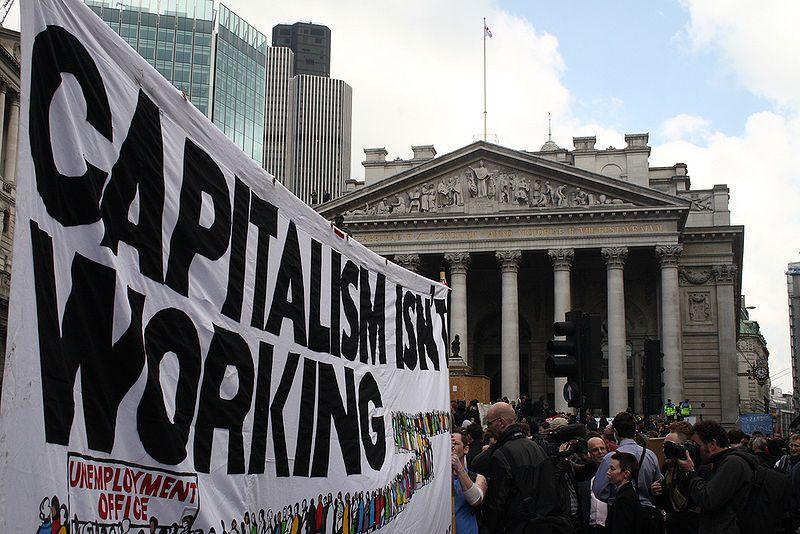Capitalism, Socialism and Over-Production Crises

Image for representational use only.
This article is meant to clarify a point made earlier (Why Didn’t Socialism Have Over-Production Crisis, Newsclick, June 30, 2018) about the erstwhile socialist economies not having over-production crises as capitalist economies do.
It is in the nature of capitalism to have “over-production crises”, i.e., crises arising from “over-production” relative to demand. “Over-production” does not mean that more and more goods keep getting produced relative to demand, so that unsold stocks keep piling up. This may happen only for a brief period in the beginning; but as stocks pile up, production gets curtailed, causing recession and greater unemployment.
“Over-production”, in short, is ex ante, in the sense that if production were to occur at full capacity use (or at some desired level of capacity utilisation), then the amount produced could not be sold because of a shortage of demand. But it manifests itself in reality in terms of recession and greater unemployment.
It is a mistake to believe that such crises are only cyclical in nature, i.e., that they get automatically reversed after a certain period of time. On the contrary, the Great Depression of the 1930s, which was a classic over-production crisis, lasted nearly a decade and was finally overcome because of the war, or, to be precise, because of military expenditure in preparation for the Second World War.
Read Also: Why Didn’t Socialism Have Over-Production Crises?
Since 2008, there has again been an over-production crisis that has persisted with varying intensity right until now. There is, thus, no question of an over-production crisis under capitalism automatically disappearing. But what was striking about the erstwhile socialist economies of the Soviet Union and Eastern Europe is that they were free from over-production crises. The question is why?
Over-production crises under capitalism arise because of two main reasons. One, investment decisions under capitalism depend upon the expected growth of demand, for which the current growth of demand is taken as a clue: if demand slows down then investment gets restrained. Two, whenever investment gets restrained, so does consumption and hence total income (this is called the “multiplier” effect of investment).
Both these factors were eliminated under socialism. Investment was undertaken according to a plan and not the dictates of profitability; hence, there was no question of investment being curtailed when the growth of demand slowed down for any reason. This is not to say that there were no fluctuations in the level of investment. These fluctuations, however, arose not in response to profit expectations, but for entirely exogenous reasons, of which, two in particular were important.
One was agricultural output fluctuations. In years when the agricultural output went down for weather-related, or some other, reasons, investment was cut, in order to prevent excessive upward pressures on food prices; correspondingly when agricultural output revived, so did investment. These investment fluctuations, however, had nothing to do with any calculations of profitability on investment; they were unavoidable even in a planned economy.
The second reason was the operation of “echo effects”. Suppose, for instance, that a whole lot of new investment had been installed in a bunched manner at a certain date, say the beginning of the planning period. These pieces of equipment would become due for retirement again in a bunched manner around the same time some years later, which would, therefore, push up the investment plan, and hence the real gross investment around that time, so that both net investment and replacement needs are accommodated. The investment figure, therefore, would not show a steady growth but would exhibit fluctuations. But these fluctuations again had nothing to do with any calculations of profitability; they arose because of past investment history.
But even when such investment fluctuations occurred, socialist economies ensured that they did not lead to fluctuations in consumption and income, i.e., those economies snapped the multiplier relationship that necessarily characterises capitalism. This is because all firms in the economy were asked to produce to their capacity, and, if demand was low because of investment being curtailed, then they were asked to lower their prices until whatever they produced got sold.
At these “market-clearing” prices, some firms would make losses, while others would still make profits; but this would not matter since both the profit-making and the loss-making firms belonged to the State, which could, therefore, cross-subsidise the loss-making ones from the profits of the profit-making ones. And taking both groups of firms together, there would always be positive net profits as long as investment was positive (even if lower than would have been otherwise).
This was a remarkable break from what happens under capitalism, and provides a clue to why output and employment fall in a crisis there. Under capitalism, a firm does not produce when prices do not cover costs; and when demand is low, prices do not fall, because they are “administered” through collusion among the oligopolistic firms. Instead, output, and hence employment, fall in order to equate supply with demand, and to eliminate stocks which might have got built up briefly.
The matter can be looked at somewhat differently. A fall in price, with money wages and employment given, which is what happened under socialism, meant a rise in the share of wages in total output; income distribution in short shifted in favour of the workers. Since workers more or less consume their entire wages, such a shift in income distribution in favour of the workers raised the share of consumption in total output. Thus, socialist economies never experienced over-production crises because even when investment fell for some reason, output was kept unchanged and the share of consumption rose to compensate for the fall in investment (through a rise in the workers’ share in output).
This, however, can never happen under capitalism because capitalists would never voluntarily agree to a lowering of their share in output and a corresponding increase in workers’ share, even in a situation of inadequate aggregate demand. This is why capitalism experiences over-production crises: income distribution here is a matter of intense class-struggle where there is no question of capitalists agreeing to lower their own share and correspondingly raise workers’ share for the sake of overcoming a situation of over-production.
The “multiplier” that operates under capitalism, whereby a reduction in investment causes a reduction in consumption and hence total output, occurs because of income distribution not being adjustable. The “multiplier”, in other words, is predicated upon the relative shares among capitalists and workers being given.
In fact, under capitalism, far from the workers’ share rising to offset the problem of insufficient demand, the tendency in periods of crisis is the exact opposite, namely, to cut wages and raise the share of profits, which, in a situation of reduced investment that brought about the crisis in the first place, actually compounds the crisis. A 10% fall in investment in such a situation does not just bring about a 10% fall in output, as the “multiplier” analysis would suggest, but a more than 10% fall in output, say a 15% fall, because an additional squeeze on consumption through a fall in workers’ share (via the wage cut) is further superimposed upon the reduction in investment.
The fact that the relative share of the workers is not allowed to increase in order to offset the tendency towards over-production, which is a basic characteristic of capitalism, also shows its supreme irrationality as a system. It shows that the system would rather have larger unutilised capacity and unemployment, i.e., a sheer waste of productive resources for lack of demand, than produce as before by avoiding this waste through giving more to the workers. From its point of view, wasted resources are preferable to using these resources to improve workers’ consumption. True, not being a planned system, it does not make such calculations consciously; but that is what its immanent tendencies amount to. Socialism avoids any waste or slack, such as is caused by a crisis, by raising the consumption of workers appropriately to avert it.
As the collapse of the Soviet Union recedes further into history, people increasingly forget that a system had existed there, which, notwithstanding its many limitations and defects, had nonetheless been free of unemployment, of over-production crises and of the irrationality of capitalism.
Get the latest reports & analysis with people's perspective on Protests, movements & deep analytical videos, discussions of the current affairs in your Telegram app. Subscribe to NewsClick's Telegram channel & get Real-Time updates on stories, as they get published on our website.
























